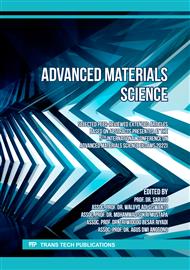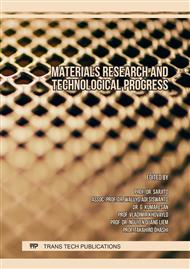[1]
J. Rams and B. Torres, Casting Aluminum Alloys,, Encycl. Mater. Met. Alloy., p.123–131, 2022,.
Google Scholar
[2]
K. R. Coran, P. Diameter, H. P. Dengan, C. Pasir, and I. Syafa, Pengaruh Model Sistem Saluran Pada Proses Pengecoran Aluminium Daur Ulang Terhadap Struktur Mikro Dan Kekerasan,, vol. 8, no. 1, p.33–39, (2012).
DOI: 10.18196/jmpm.v5i1.12441
Google Scholar
[3]
J. V. Christy, R. Arunachalam, A. H. I. Mourad, P. K. Krishnan, S. Piya, and M. Al-Maharbi, Processing, Properties, and Microstructure of Recycled Aluminum Alloy Composites Produced Through an Optimized Stir and Squeeze Casting Processes,, J. Manuf. Process., vol. 59, no. September, p.287–301, 2020,.
DOI: 10.1016/j.jmapro.2020.12.030
Google Scholar
[4]
B. K. Dhindaw, G. S. L. Aditya, and A. Mandal, Recycling and Downstream Processing of Aluminium Alloys for Automotive Applications. Elsevier Ltd., (2020).
DOI: 10.1016/b978-0-12-803581-8.11491-2
Google Scholar
[5]
E. Sriwahyudi, B. Kusharjanta, and W. Purwo, POROSITAS DAN NILAI KEKERASAN PADA PENGECORAN Keywords : Abstract :,, Mekanika, vol. 13, no. September, p.43–50, (2014).
Google Scholar
[6]
S. R. Sama, T. Badamo, P. Lynch, and G. Manogharan, Novel sprue designs in metal casting via 3D sand-printing,, Addit. Manuf., vol. 25, p.563–578, 2019,.
DOI: 10.1016/j.addma.2018.12.009
Google Scholar
[7]
A. K. Eqal, Experimental and simulation study of solidification of commercial pure aluminium by sand casting,, Mater. Today Proc., (2021).
DOI: 10.1016/j.matpr.2021.01.630
Google Scholar
[8]
M. Jolly and L. Katgerman, Modelling of defects in aluminium cast products,, Prog. Mater. Sci., vol. 123, no. May, p.100824, 2022,.
DOI: 10.1016/j.pmatsci.2021.100824
Google Scholar
[9]
Y. Li, J. Liu, G. Zhong, W. Huang, and R. Zou, Analysis of a diesel engine cylinder head failure caused by casting porosity defects,, Eng. Fail. Anal., vol. 127, p.105498, 2021,.
DOI: 10.1016/j.engfailanal.2021.105498
Google Scholar
[10]
S. S. Lim, J. C. Mun, T. W. Kim, and C. G. Kang, Development of low-temperature high-strength integral steel castings for offshore construction by casting process engineering,, Int. J. Nav. Archit. Ocean Eng., vol. 6, no. 4, p.922–934, 2014,.
DOI: 10.2478/ijnaoe-2013-0222
Google Scholar
[11]
A. Sunanda and M. V. J. Raju, Simulation for prediction analysis of defects in pulley casted using sand casting process,, Mater. Today Proc., (2021).
DOI: 10.1016/j.matpr.2021.01.734
Google Scholar
[12]
Y. Huang, Y. Yuan, L. Yang, D. Wu, and S. Chen, Real-time monitoring and control of porosity defects during arc welding of aluminum alloys,, J. Mater. Process. Technol., vol. 286, no. April, 2020,.
DOI: 10.1016/j.jmatprotec.2020.116832
Google Scholar
[13]
Y. Wang, C. Hu, K. Chen, and Z. Yin, Self-attention guided model for defect detection of aluminium alloy casting on X-ray image,, Comput. Electr. Eng., vol. 88, no. March, p.106821, 2020,.
DOI: 10.1016/j.compeleceng.2020.106821
Google Scholar
[14]
K. Kurtulus, A. Bolatturk, A. Coskun, and B. Gürel, An experimental investigation of the cooling and heating performance of a gravity die casting mold with conformal cooling channels,, Appl. Therm. Eng., vol. 194, no. May, 2021,.
DOI: 10.1016/j.applthermaleng.2021.117105
Google Scholar
[15]
S.-S. Shin, S.-K. Lee, D.-K. Kim, and B. Lee, Enhanced cooling channel efficiency of high-pressure die-casting molds with pure copper linings in cooling channels via explosive bonding,, J. Mater. Process. Technol., vol. 297, p.117235, 2021,.
DOI: 10.1016/j.jmatprotec.2021.117235
Google Scholar



